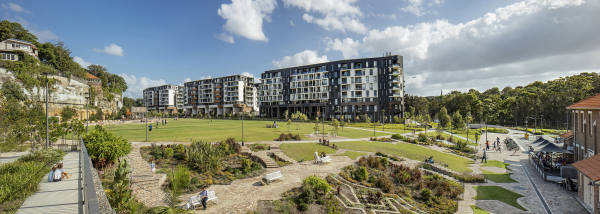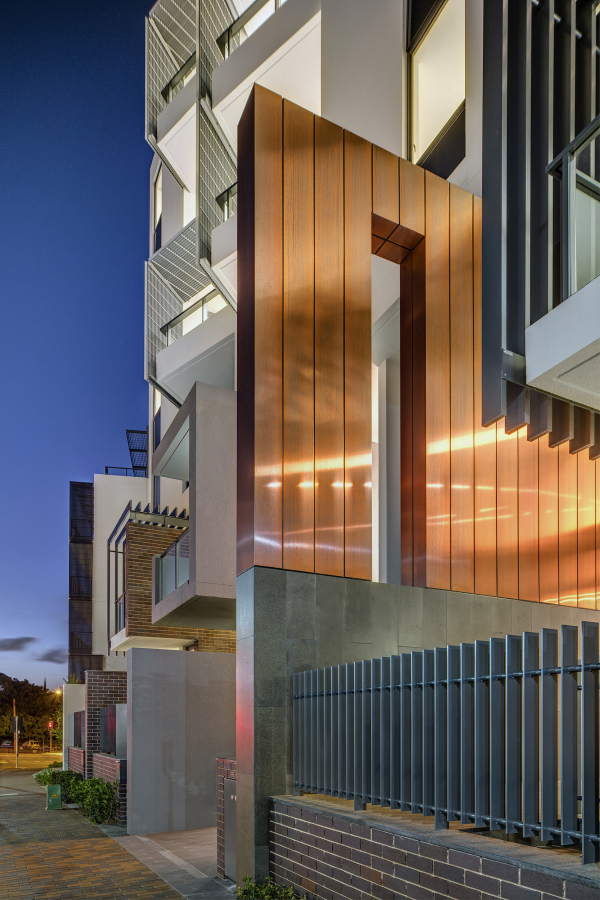









Image Credit : 1Harold Park: Simon Wood
2Harold Park: Simon Wood
3Harold Park: Murray Fredericks
4Harold Park: Luc Remond
5Harold Park Tramsheds: Luc Remond
6Harold Park: Nelson Cortez
7Harold Park: Mirvac Design
8Harold Park: Mirvac Design; Murray Fredericks
9Harold Park: Mirvac Design; Luc Reymond
10Harold Park: Mirvac Design; Simon Wood

Project Overview
Respect and reinterpretation of traditional Inner West values was the creative inspiration for Harold Park. Eight years of staged development later, Harold Park has reimagined urban life for residents and unlocked a new green village heart for the wider community.
Seven new residential buildings harness a mix of innovative architectural solutions to sit low and comfortably in the landscape, anchored by a unique retail centrepiece Tramsheds together with 3.8 hectares of new public parkland.
These distinct new built forms achieve a cohesive aesthetic that complement the surrounding urban fabric, heritage elements, park and sandstone cliff face. The adaptive reuse of the former home of the Rozelle Tram Depot into a vibrant European-style marketplace allows visual interpretation of the site’s cultural significance.
The new parkland connects Forest Lodge, Glebe, Annandale and the harbour foreshore, unlocking a new community heart.
Form, space and ambience of the site engage new residents and established neighbours and unify these community emotionally, socially and physically.
Organisation
Team
A project of this scale requires collaboration. Mirvac Design was the lead and executive architect for the 8 year project. Mirvac Design worked in collaboration with over 40 consulting teams including the following leading architect and design practices:
• SJB Architects (for Precinct 2 “Eden”)
• Eeles Trelease Pty Ltd (for Precinct 3 “Maestro”)
• Smart Design (for Precinct 4a “Maxwell”)
• PTW (for Precinct 5 “Vance”)
Project Brief
Harold Park’s location is a vast and historic inner-city site of profound importance to the community.
The challenge was to sensitively redevelop on 10 hectares set between the well-established suburbs of Annandale, Glebe and Forest Lodge, in a way that would entice new Inner West residents while enriching life and exceeding expectations for the existing community, council and other stakeholders.
Along with supplying a critical mass of high-quality housing for a discerning market, redevelopment would need to honour the past and sustain a legacy of servicing the community.
To reflect and add to the richly layered fabric so beloved in the Inner West, seven distinct architectural solutions were conceived via a collaborative approach. Mirvac Design worked together with SJB (for the ‘Eden’ building), Eeles Trelease (for ‘Maestro’), Smart Design Studio (for ‘Maxwell Place’), and PTW (for ‘Vance’).
New forms needed to integrate with the existing landscape, activated at the heart by adaptive reuse of the heritage tram depot buildings and curtilage. The function of open space, light and shadow would be vital in encouraging public interaction and engagement, enhancing access and promoting collective memory by allowing cultural significance of the site to be interpreted by future generations. Future users would best respond to a village-like ambience to support their Inner West lifestyle and values.
Project Innovation/Need
Harold Park’s innovation lies in using new design solutions to resolve traditional Inner West values, resulting in a fresh, more social approach to medium-density.
Seven new buildings pick up the vertical rhythm of the surrounding 19th-century fabric, and a network of activated streetscapes reflects the geometry of neighbouring suburbs. Building mass is broken down by a mix of façade materials and form, recessed mansard roofing and a terrace typology at the base of buildings.
In terms of construction, the Tramshed’s European-inspired mansard was without local precedent, so extensive detailing workshops were undertaken with the roofing contractor to achieve acoustic, thermal, waterproofing and aesthetic requirements.
Materials were selected for longevity and as a contemporary interpretation of traditional Victorian ornamentation. For example, standing seam roof sheeting, face brick, bronze, decorative pressed metal panelling, reinvented palisade fencing, and coloured glass reminiscent of leadlight.
The mix of forms creates textural richness. Maxwell Place, for instance, sits long and low in the shadow of the sandstone cliff face. Its bright, white, angular form echoes the sawtooth roof of the adjacent Tramsheds without overpowering it.
The vast central space maintains view corridors and maximises morning light into the northeast-facing residences and parkland while shading the Tramsheds’ forecourt, which welcomes a daily mix of prams, dog-walkers, shoppers, school kids, diners and commuters.
An unprecedented proportion of open public space (35%) has been seamlessly integrated with pocket parks, walk/cycle ways and green plazas woven throughout the built precincts to promote social interaction, village ambience and wellbeing of residents.
Design Challenge
The key design challenge was related to the complexity of project phasing. Harold Park was portioned into precincts for staged development over 8.5 years and it required careful planning and efficient problem-solving at a sitewide level to ensure multi-staged infrastructure works were completed successfully and on time, concurrent with individual precinct building works.
This meant some iterative design changes throughout the stages that would allow all buildings to complete and settle on or ahead of schedule and ensure financial feasibility of the project.
The strength of Mirvac’s all-under-one-roof knowledge and delivery model ensured optimum communication, flexibility and speed implementing these changes while maintaining the highest build quality and user satisfaction.
Sustainability
Harold Park has set a benchmark in sustainability with residential buildings achieving a 6-Star Building Sustainability Index and apartments exceeding BASIX energy and water targets by 25%.
Among the extensive measures in the residential precincts are rainwater harvesting, stormwater retention, solar panels, green roofs, energy-efficient appliances.
The masterplan also facilitates greener transport options with dedicated routes for cycling and walking, enhanced access to the adjacent light rail and buses, and car-share spaces.
In meeting conservation objectives for the heritage buildings, as much of the original fabric as possible has been retained, reused or restored, including all brickwork.
Natural features of the site have been remediated, including the heritage cliff face and a row of mature fig trees, and significant public green space has been reintroduced to the inner city.
Along with environmental sustainability, Harold Park has achieved social sustainability by creating a new community heart connecting surrounding suburbs while unlocking a historic pocket of Sydney for all to enjoy.
History is woven into new buildings via site markers plus naming of buildings and streets after the equine champions of the Paceway’s legendary Miracle Mile. Timber from the Paceway track has been upcycled into an entry statement in the lobby of ‘Locarno’.
Construction, materials and infrastructure are of the highest quality for long-term value and to honour the site’s cultural significance.
Finally, Harold Park residents are saved the strata-raising cost of high-maintenance facilities and instead encouraged to enjoy the vast free green space at their door, and the amenities within Tramsheds.
Architecture - Multi Residential - Constructed
This award celebrates the design process and product of planning, designing and constructing form, space and ambience that reflect functional, technical, social, and aesthetic considerations. Consideration given for material selection, technology, light and shadow.
More Details


